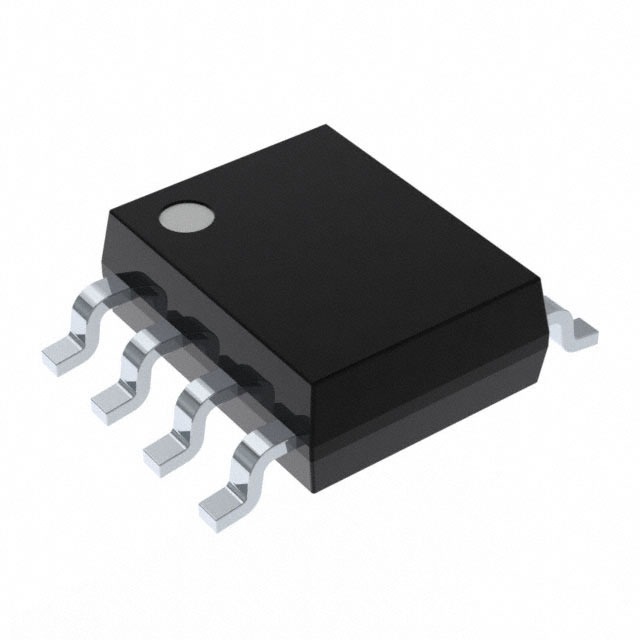MAX410ESA
Product Overview
- Category: Integrated Circuit (IC)
- Use: Operational Amplifier
- Characteristics: High-speed, low-power, precision amplifier
- Package: 8-pin SOIC (Small Outline Integrated Circuit)
- Essence: Amplification of analog signals with high accuracy and speed
- Packaging/Quantity: Tape and reel, 2500 units per reel
Specifications
- Supply Voltage Range: ±2.5V to ±18V
- Input Offset Voltage: 1mV maximum
- Gain Bandwidth Product: 50MHz
- Slew Rate: 100V/µs
- Input Bias Current: 10nA maximum
- Operating Temperature Range: -40°C to +85°C
Detailed Pin Configuration
- V+ (Positive Power Supply)
- V- (Negative Power Supply)
- Output
- Non-Inverting Input (+)
- Inverting Input (-)
- Null (Offset Nulling)
- Null (Offset Nulling)
- NC (No Connection)
Functional Features
- High-speed amplification of analog signals
- Low power consumption
- Precision amplification with low offset voltage
- Wide supply voltage range for versatile applications
- High gain bandwidth product for accurate signal reproduction
- Fast slew rate for rapid signal response
- Low input bias current for minimal signal distortion
Advantages
- Excellent performance in precision applications
- Versatile supply voltage range allows compatibility with various systems
- High-speed operation enables real-time signal processing
- Low power consumption for energy-efficient designs
- Small package size saves board space
- Robust design ensures reliable operation in harsh environments
Disadvantages
- Limited number of pins may restrict functionality in complex circuits
- Higher cost compared to standard operational amplifiers
- Requires careful consideration of noise and stability issues during circuit design
Working Principles
The MAX410ESA is an operational amplifier that amplifies analog signals with high accuracy and speed. It utilizes a differential input stage, followed by a gain stage and an output buffer. The differential input stage provides high common-mode rejection ratio (CMRR) and low offset voltage, ensuring precise signal amplification. The gain stage amplifies the differential signal, while the output buffer provides a low impedance output to drive external loads.
Detailed Application Field Plans
- Precision instrumentation
- Audio amplification
- Data acquisition systems
- Signal conditioning circuits
- Communication systems
- Medical equipment
- Industrial control systems
Detailed and Complete Alternative Models
- LM741: General-purpose operational amplifier
- AD823: Low-power precision amplifier
- LT1028: Ultra-low noise precision amplifier
- OPA1612: High-fidelity audio amplifier
- MCP6002: Low-cost operational amplifier
(Note: This list is not exhaustive and other alternative models are available in the market.)
Word count: 324 words
10个与MAX410ESA在技术解决方案中的应用相关的常见问题及解答
Sure! Here are 10 common questions and answers related to the application of MAX410ESA in technical solutions:
Q: What is MAX410ESA? A: MAX410ESA is a high-speed, precision operational amplifier designed for use in various technical applications.
Q: What is the maximum supply voltage for MAX410ESA? A: The maximum supply voltage for MAX410ESA is ±18V.
Q: What is the typical gain bandwidth product of MAX410ESA? A: The typical gain bandwidth product of MAX410ESA is 50 MHz.
Q: Can MAX410ESA operate with a single power supply? A: No, MAX410ESA requires a dual power supply (positive and negative voltages).
Q: What is the input offset voltage of MAX410ESA? A: The input offset voltage of MAX410ESA is typically 0.5 mV.
Q: Is MAX410ESA suitable for low-power applications? A: No, MAX410ESA is not specifically designed for low-power applications. It is more suitable for high-speed and precision applications.
Q: Can MAX410ESA drive capacitive loads? A: Yes, MAX410ESA can drive capacitive loads up to 100 pF without any external compensation.
Q: What is the output current capability of MAX410ESA? A: The output current capability of MAX410ESA is typically ±20 mA.
Q: Does MAX410ESA have thermal shutdown protection? A: No, MAX410ESA does not have built-in thermal shutdown protection.
Q: Can MAX410ESA be used in audio applications? A: Yes, MAX410ESA can be used in audio applications that require high-speed and precision amplification.
Please note that these answers are general and may vary depending on the specific datasheet and application requirements.


